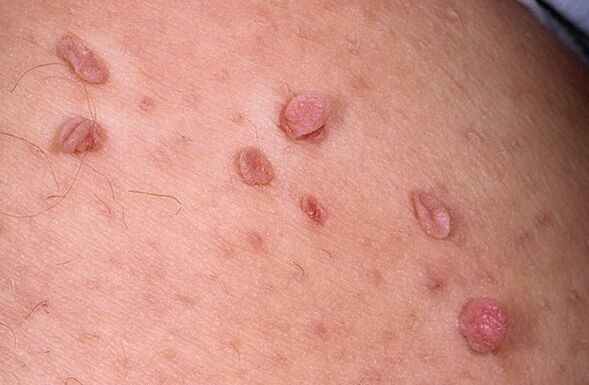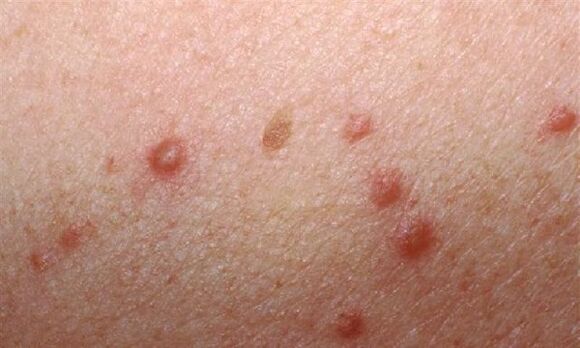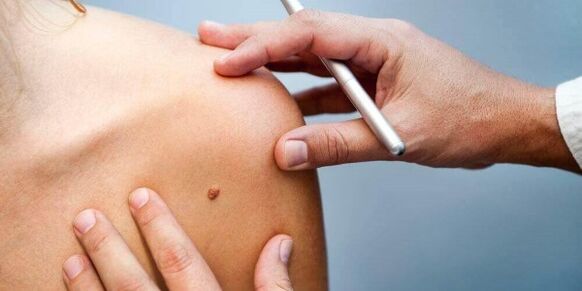In most cases the causes of papillomas on the surface of the body in women are associated with infection of the body with the papillomatosis virus. There are also congenital formations that are transmitted along with genetic information from one of the parents.
What are papillomas
Papillomas are benign neoplasms of the female body, and their causes are the pathogenic activity of viral microorganisms from the papillomavirus family. Translated from Latin means "papillo - nipple" and "oma - a typical end for tumors of all kinds. "
Papillomas are formed from the epithelial cells of the host itself. Externally, it has the appearance of a connective papilla with a flat, sharp, round or branched shape.
A distinctive feature of benign neoplasms of this type is that they are able to develop mucous membranes of the oral cavity, internal organs with a hollow structure, inside the nasal openings, nasal nipples, on the vocal cords.
First, the papilloma root is formed from squamous epitheliiam with gradual growth of the general skin.

The color of the tumor can range from fleshy to brown and pink. . . Localization of papilloma inside the bladder, intestines, organs of the respiratory system can lead to the development of concomitant diseases and complications.
Types of papillomas on the body in women
Depending on the location of the warts, their appearance and the reasons that caused their formation, different types of papillomas are distinguished. The table below lists the types of benign neoplasms of this type, showing their features.
| Type of papilloma | Characteristics of the neoplasm |
|---|---|
| Genital warts | They can be located in any part of the female body. Externally, they look like a rectangular hanging mole, which in most cases has a brown tint. |
| Papilloma vulgaris | The classic form of the manifestation of the human papillomatosis virus. The neoplasms are round in shape; they are attached to the main surface of the body on a thin and short stem. Is the color of meat similar to the rest of the dermis. |
| Genital warts | Localization of neoplasms of this type is the intimate zone in both men and women. Infection occurs as a result of unprotected intercourse with an infected partner. The main location of the tumors is the circumference of the anus, the labia majora and minora in women, and the foreskin in men. Where sanitary and hygienic standards are not met, domestic contamination can occur. |
| Senile warts | Found in older women. They appear as a result of hormonal changes in the body, metabolic disorders, prolonged exposure to the open rays of the sun. The main risk of this type of papillomas is the high risk of their worsening in malignant neoplasms. |
| Plantar | Papillomas of this type are localized exclusively in the area of the plantar part of the foot. Externally, they resemble a small cauliflower head with branched inflorescences. If a woman walks a lot, if she wears tight shoes, the plantar warts can become inflamed, bleed and cause pain. |
Almost all of the above types of papillomas are created as a result of a woman 's infection with one or another genotype of the human papillomavirus virus. The only exceptions are senile warts, which appear due to age-related changes in the body of the elderly.
Stages and stages of papillomas on the body in women
Like any other benign tumor formation, papilloma develops on a woman’s body in several stages.
In this regard, the following stages of wart formation are distinguished:
- Step 1- uncontrolled division of the squamous cell epitheliiam and papilloma root formation, which is asymptomatic and imperceptible;
- Step 2- can lead to a feeling of a wart head, which rises 1-1. 5 mm above the general surface of the body, if located at the folds of the joints, in the area of the girdle, on the neck or under the amperes. discomfort, chafing, skin irritation;
- Step 3- appears to be a flat, round or angled full-thickness neoplasm, with a root, leg, main body in the form of a head and a blood supply due to the smaller capillary vessels attached to the rest of the epithelial tissues;
- Step 4- multiple proliferation of similar papillomas, formed as a result of several cells of an existing neoplasm (extensive papillomatosis is dangerous with a high probability of malignant degradation of any wart).
The dermatologist determines the stage of the skin disease during the examination of the patient. The method of treatment is selected based on the diagnostic findings, the type of papilloma and the extent of its development.
Symptoms of papilloma
Papillomas are single or multiple benign tumors on the body (the causes in women caused by the appearance of neoplasms) that are easily identified by external signs.
Symptoms of papillomatosis in women are manifested as follows:
- appearance of small tubers rising above the general surface of the epitheliiam;
- an increase in the root of the wart, which becomes larger each week;
- an external neoplasm is visible on the body, characterized by a round, branched or conical shape;
- The main localization of papillomas on the female body are the amputations, inner thighs, neck, skin surface under the mammary glands, groin area, perineum, genitals, back, plantar portion of foot;
- in case of prolonged exposure to the surface of the wart, tearing and pain may occur;
- papilloma can have a fleshy, yellow, pink, brown shade, which is normal;
- attempts to remove the neoplasm themselves do not yield a positive result, and the cut wart grows back.

These symptoms are frightening symptoms such as a sudden change in the color of the wart to darker colors, the onset of an acute inflammatory process, the release of pus or blood fluids, pain attacks, which are not characteristic of papillomatosis. In this case, degradation of benign formation in a cancerous tumor is not excluded.
Reasons for the appearance
Papillomas of the body (the causes in women that triggered the disease with the patient's lifestyle) are chronic dermatological pathology that appear under the influence of the following factors.
Factors of papillomas on the body:
- leading a promiscuous sex life, having intimate contacts with an infected partner without using barrier contraception;
- sharing towels, cosmetics, soap and other hygiene products with someone who is ill with papillomavirus virus;
- sharing indoor slippers and other types of footwear;
- visit public showers, baths, swimming pools, steam rooms with open skin contact surfaces where viable papillomavirus virions are present;
- hormonal imbalance in the body caused by concomitant diseases of the endocrine system;
- getting a viral infection in an open womb while shaving;
- infection of a child from a sick mother during the passage of the fetus through the birth canal.
In most cases, the true cause of the appearance of warts on the body cannot be established. The incubation period of papillomavirus virus after infection is between several days and 3 years or more.
Diagnostics
To make an accurate diagnosis in the form of papillomatosis, a woman must perform a comprehensive examination of the body and directly on the skin area where the benign neoplasm is localized.
Papillomas are diagnosed in several stages, namely:
- visual examination by a dermatologist;
- donate venous blood for biochemical studies and determination of papillomavirus virions;
- examination of the deeper epithelial layers of the wart using a dermatoscope;
- collecting capillary blood for clinical analysis;
- selection of a papilloma particle for further histological examination in order to exclude the oncological nature of the origin of the tumor;
- deliver morning urine to determine its biochemical composition and general indicators of a woman's health.
A gynecologist may require further examination of the localization of papillomas in the intimate area, genitals and perimeter of the anus, as well as tests for the presence of sexually transmitted infections.
When to see a doctor
The main danger of this type of warts is aesthetic defect, as well as the risk of deterioration in oncology.
It is recommended to seek the advice of a dermatologist as soon as the appearance of a foreign neoplasm is detected.
Early diagnosis and determination of the type of papilloma allows you to organize effective treatment and remove the neoplasm with the least possible risk of complications.
Prevention of papillomas on the body
Papillomas are benign tumors on the body (causes of warts in women can be eliminated with effective preventive measures) that can be easily prevented by following the following rules.
For example:
- to have an orderly personal life, having only one sexual partner;
- only wear your own shoes and do not let others shoe them;
- use of barrier contraception;
- avoid visiting public baths, toilets, pools, showers, or put your feet in rubber slippers, do not touch open body parts on wall surfaces, door handles, tiles, sun loungers;
- use only your own cosmetics, towels, soap;
- at least once a year to undergo a preventive medical examination by a dermatologist;
- balanced nutrition, sleep at least 8 hours a day, enough rest to ensure normal functioning of the immune system.
All of the above recommendations do not guarantee 100% protection against infection with papillomatosis, but they do allow you to minimize the risk of the disease and avoid contact with potential sources of infection.
Methods for treating papillomas of the body in women
Papillomatosis is a completely unacceptable disease. A woman who has carried the virus that causes warts makes her carry the rest of her life. Modern methods of treating the disease can not get rid of the consequences of pathology in the form of benign neoplasms.
Medications
Traditional medicines do not completely remove papillomas, since warts of this type must be removed by chemical, thermal, electroconvulsive, laser or surgical treatment.
Traditional methods
Alternative medicine offers its own alternative ways to get rid of papillomas, regardless of their type and location on the female body. Here are traditional methods to remove warts.
Knit with thread
It is necessary to wait until the lunar phase is at the stage of weakening. You will need to take a piece of black thread, use it to tie the papillomas, and tie a knot. This thread is taken out to the garden and placed in the soil with the words: "When this thread rots, all my warts will disappear. " After 2-3 weeks, the papilloma will start to narrow and fall off. without signs of pain or inflammation.
Special methods
There are special remedies for warts and papillomas, but they do not give the effectiveness of their action and guarantee a relapse. One of these tools, for example, a special patch.
Such products usually contain natural ingredients that fight the virus to some extent.
Dog saliva
To get rid of benign neoplasm while using this method, you need to spread the wart with a flat layer of sour cream. Next, the woman should go to the dog so that he hits the lactic acid product with his tongue.
After that, the papilloma is sealed with a medical adhesive plaster. Saliva cannot be removed from the surface of the neoplasm. After 1 week, the patch can be removed. From this point on, the wart will start to crumble.
Moxibustion with celandine
During the growing season of this plant (from late May to mid-June), you should pluck celandine branches daily and add the warts with poisonous yellow juice. The duration of therapy is 10 to 30 days. Precautions should be taken to prevent the juice from entering the mucous membranes of the mouth and eyes.
Official science has not proven the effectiveness of the use of the above folk remedies to remove papillomas from the body. Women who have used similar prescriptions have been able to achieve the desired result and respond positively to these methods of therapy.
Other methods
The most effective way to treat papillomas is to remove them completely.
For this purpose, the following methods are used:
- chemical burning- exposure to the surface of the wart with aggressive solutions based on sodium acids, potassium or alkali is provided for;
- electro-heating- the papilloma is cut out and cauterized using a loop-shaped instrument, whose metal end is electrically conductive (the treatment procedure is performed under local anesthesia);
- cryodestruction- benign neoplasm is burned with liquid nitrogen solution (under the influence of low temperatures, epithelial tissue freezes and then dissolves into parts);
- laser coagulation- the papilloma is extinguished by the use of positively charged laser particles, the main body of the wart is removed and its root system is cauterized;
- surgical removal- the traditional and most common method of treating dermatological disease, which is to exclude the scart with a scalpel and then apply an ambitious material.

All of the above methods of treating papillomatosis allow you to remove benign neoplasms with the least risk of recurrence of the disease.
The average recovery period is 3 to 7 days. The safest method is laser excision and electrocoagulation. The most painful and traumatic treatment is traditional surgical removal of the wart.
Potential complications
In the absence of adequate response measures and treatment of papillomatosis on the body, over time, a woman may face the following complications.
Possible complications:
- the appearance of similar warts on other parts of the body, indicating an increase in viral activity;
- degradation of the wart into a malignant, potentially fatal cancerous tumor;
- occurrence of similar neoplasms in the cavity of the bladder, intestines, larynx, trachea, leading to disruption of their work, problems with urine, breathing, and digestive function;
- cervical cancer (scientific studies have shown that 80% of women suffering from this disease are infected with human papillomavirus virus;
- increase in wart size, creation of cosmetic and aesthetic defect;
- injury to the neoplasm and entry of bacterial infection into the epithelial tissues.
To prevent the appearance of papillomas on the body in women, it is necessary to remember the reasons why they occurred. This will preserve the health of the skin, avoid a decrease in the immune status of the pathogenic activity of the papillomavirus. The disease itself is not life-threatening, but its presence can trigger the development of major complications.














































































